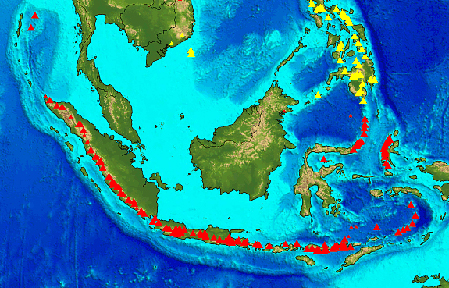
Geotimes Home | AGI Home | Information Services | Geoscience Education | Public Policy | Programs | Publications | Careers

 On Tuesday,
two volcanoes erupted to life in Indonesia, killing at least two people, injuring
others and forcing the evacuation of thousands.
On Tuesday,
two volcanoes erupted to life in Indonesia, killing at least two people, injuring
others and forcing the evacuation of thousands. Indonesia is one of the world's hotbeds of volcanic activity. The island nation is host to more than 100 active volcanoes, two of which roared to life on Tuesday. Large red triangles show volcanoes with known or inferred Holocene eruptions. Photo courtesy of Global Volcanism Program.
Meanwhile, Mount Awu on Great Sangihe Island in the far northwest of Indonesia
about 2,250 kilometers from Jakarta, also erupted on Tuesday in a series of
small blasts, followed by a large eruption of hot ash, according to Reuters.
The ash and smoke column, now 2,000 meters high, forced the evacuation of more
than 10,000 people living in small towns in the volcano's shadow. The 1,320-meter-tall
volcano has historically been one of the deadliest in Indonesia, according to
the Smithsonian/U.S. Geological Survey Global Volcanism Program. Since 1711,
five explosive eruptions at Mount Awu, including the most recent in 1966, have
killed more than 8,000 people.
Indonesia sits atop the seismically active Pacific "ring of fire."
The country hosts more than 100 historically active volcanoes — more than
any other country — and has more people living in close proximity to active
volcanoes than anywhere else on Earth (Geotimes,
April 2004).
Megan Sever
Links:
Global
Volcanism Program
Reuters
news story on Yahoo
Associated
Press news story on CNN
"In Harm's Way: Population
and Volcanic Risk," Geotimes, April 2004
 |
Geotimes Home | AGI Home | Information Services | Geoscience Education | Public Policy | Programs | Publications | Careers |